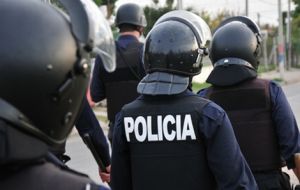MercoPress. South Atlantic News Agency
Cost of crimes against property and people in Uruguay estimated at 3.1% of GDP
 Crime rates in Uruguay are generally lower than in the rest of Latam but the issue is now at the top of the public agenda
Crime rates in Uruguay are generally lower than in the rest of Latam but the issue is now at the top of the public agenda The cost of crimes against property and people in Uruguay in 2010 totaled at least 1.2 billion dollars, which was equivalent to 3.1% of the country’s GDP. This was the conclusion of a new study carried out at the country’s Economic Research Center by researchers Aboal Diego, Jorge Campanella, and Bibiana Lanzilotta, with the collaboration of Magdalena Dominguez and Maren Vairo.
The study is one of eight selected in a competition organized by the Inter-American Development Bank (IDB) to measure with appropriate methodologies and innovation the cost of crime and violence in Latin America and the Caribbean.
Crime rates in Uruguay are generally lower than in other Latin American countries. However, the growth of certain crimes over the past 20 years has put the subject at the top of the public agenda, according to the study. It adds that cost calculations for crime can be a useful input for formulating public policy and public debate.
The research analyzes kinds of criminal activities as follows: property crimes (76% in 2010), personal injury crimes (14.4%), sexual crimes (0, 6%), smuggling (0.1%), and other offenses (8.8%).
The study’s calculi include the cost of security and crime prevention, the criminal justice system, incarceration and rehabilitation of criminals, stolen goods, health, loss of life, and loss of productive time of prison inmates.
It then groups costs in three categories: those incurred in preparing for crime, as a consequence of crime, and in response to crime.
The largest component of the total figure is costs associated with preparing for crime, which account to 738 million dollars, or 1.9% of GDP. Included was public and private spending on security and administrative costs of insurance companies.
The second largest component was the result of crime, where costs totaled 319m dollars, or 0.81% of GDP. Included was the cost of stolen property, opportunity time in prison, homicides, and intangible costs of victims of other crimes.
The third component was costs of responding to crime, which totaled 145m dollars, equivalent to 0.37% of GDP. This includes public spending on the judiciary, incarceration and rehabilitation, and private expenditure on criminal legal aid.
Finally, the study highlights limitations in the analysis that tend to result in lower estimates of total costs. Therefore, according to the study, the estimate that crime costs the equivalent of 3.1% of GDP should be considered a working floor.




Top Comments
Disclaimer & comment rules-

-

-

Read all commentsWhat a pity the opportunity was lost to regionalise the data.
Feb 02nd, 2013 - 06:29 pm 0I bet that Montevideo took the lions share and the real cause was a 'neighbours' to the south and their drug dealing gangsters pushing into the next biggest city in the area after BsAs.
The real problem of course is the usual one for SA: the Policia are ineffective and rely on the public to feed them information to close out the crimes. Detection seems to be an unknown police activity but the Policia Caminera (Highway Police) are always out to catch speeding motorists by the use of the old fashioned freehand radar guns. Am I being cynical that the fines are what attract the activity and not road safety?
If road safety were the object why do I see so many dangerous vehicles on the roads? You can always spot a moto (motorcycle) [110 ~ 125 cc] that has no brakes: the rider drives slowly and wears heavy shoes or even industrial boots instead of trainers, so that they can stop the things; and I kid you not.
I am waiting for the car to show up with boots sticking out through the floor, it will happen, I am sure of it.
ChrisR - I have a low enough opinion of the policía caminers, but I do believe they were worse a few years ago. I got a fine for a broken headlamp (on the Rambla Portuaria of all places), and the policeman involved wrote the ticket with no prevaricating for me to offer a bribe. Pity his mates on the Interbalnearia couldn't care less about vehicles with no lights at all.
Feb 02nd, 2013 - 07:28 pm 02 ynsere
Feb 03rd, 2013 - 05:32 pm 0“Pity his mates on the Interbalnearia couldn't care less about vehicles with no lights at all.”
Absolutely.
A young (19 yo) well known in the area was killed pushing her bike across the IB (I am still amazed that this is allowed) and the local paper played blue murder.
Now we have the Pol-Cam in TWO vans, one each side of the IB with cones out to pull the traffic to one lane per side, right next to the death site.
I saw two rear end shunts in one trip caused by this action.
As my best friend, a Spaniard who has lived in Uruguay for over fifty years said to me: “you are correct Chris that the Uruguayos are a great people, it's just a pity they have no brains when it comes to serious matters”.
I could not argue with him about this shocking, unnecessary and preventable death.
Commenting for this story is now closed.
If you have a Facebook account, become a fan and comment on our Facebook Page!